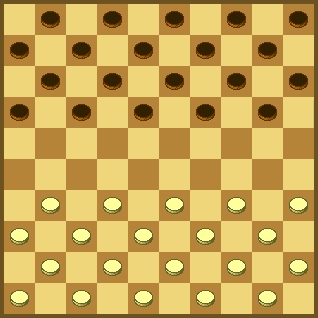

Modern draughts (also called Killer Light ) is a variant of Dame (International Draughts). The Dame must land immediately behind the last captured piece, provided (1) that it is a Dame and (2) it’s a multiple capture sequence. This serves to reduce the drawishness of the game, since it means that three Dames will win against
a lone Dame. Note that, unlike in Killer Draughts (here), the halt rule is not valid at single piece capture.
Background
In 1922, Dutch champion A.K.W. Damme proposed to use the Dame halt rule after the final piece (Man or Dame) only. Around 2000, Christian Freeling proposed Killer Draughts (here) by introducing condition “only after a final Dame”. In 2016, Juri Anikejev suggested “Killer light” (Modern Draughts) by introducing “only after a final Dame in multiple capture sequences”. The Dame halt rule is well-known in Gothic checkers variants (here), although the rule also applies to enemy men.
An interesting variant was suggested by World Champion H. Hoogland, in 1923. The only difference is that the Dame can also capture orthogonally, but only when a Dame can be captured. Thus, two Dames will win against a lone Dame. (This is implemented as a variant.)
Piece movement
The object is to capture all your opponent’s men by jumping over them, or
stalemate the opponent so he has no moves. A Man can move
forward, by a diagonal step to an adjacent empty square. It
may also jump over an enemy piece in any diagonal direction to a
vacant square on the other side. Jumping over a piece captures it.
Capturing is
mandatory, and you must keep jumping and capturing as long as it is possible.
You must even choose beforehand the series of jumps that captures the most men.
When your Man reaches the other end of the board, it becomes a Dame and can
then move and capture forwards and backwards over any distance. It also
jumps to capture, but only one Man at a time. A Dame must also choose the line that
captures the most men. If a Man reaches the promotion square as part of a capture sequence, it does not promote.
Examples
 White wins by going to the square marked green. Black must land on the square marked red, because it is a multiple capture. White can then make the final capture.
White wins by going to the square marked green. Black must land on the square marked red, because it is a multiple capture. White can then make the final capture.
 Although this is a simple win in Killer Draughts, it is more difficult in Modern Draughts. Arguably, this speaks in favour of Modern Draughts.
Although this is a simple win in Killer Draughts, it is more difficult in Modern Draughts. Arguably, this speaks in favour of Modern Draughts.
2-7, 28-32, 7-11, 27-18, 11-50, 26-42, 50-39, 42-47, 39-50, 47-20, 50-44, 32-19, 44-11, 19-23, 11-39, 18-1, 39-6, 20-15, 36-41, 23x46, 6-22, 46-14, 22-39, 1-18, 39-44, 18-29, 44-22, 14-28, 22x33x24x, 15x47 1-0
Modern Checkers (8x8)
Modern Checkers (8x8) is played on an 8x8 board with 12 pieces per player. The only difference from Brazilian Checkers (Minor Polish draughts) is the following: in a capture sequence (but not single capture), the Dame must stop on the first vacant square after the last captured piece, if and only if that piece is also a Dame. Minor Polish draughts was known already in the 16th century, and possibly even earlier. It was a popular board game in Holland, especially in Amsterdam.
References
‘World Draughts Forum: Killer Draughts’. (here)
‘World Draughts Forum: On the origin of Killer variants’. (here)
‘Mindsports: Killer Draughts’. (here)
See also:
Winther, M. (2015). ‘International/Polish Checkers Variants’. (here)
-------- (2017). ‘Spanish Checkers Variants’. (here)
-------- (2017). ‘Gothic Checkers Variants’. (here)
You can download my free Modern Draughts program here (updated 2020-10-17), but you must own the software Zillions of Games to be able to run it. (I recommend the download version.)
© Mats Winther, 2016.